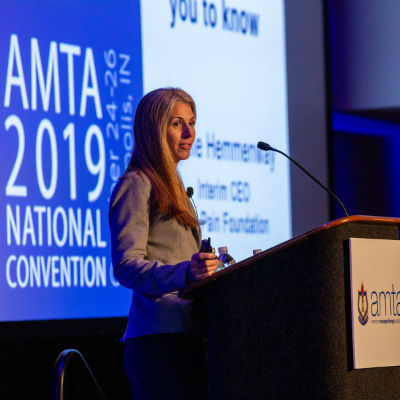 Interim CEO Nicole Hemmenway was one of three keynote speakers at the closing session of the American Massage Therapy Association (AMTA) national convention last weekend in Indianapolis, IN.
Interim CEO Nicole Hemmenway was one of three keynote speakers at the closing session of the American Massage Therapy Association (AMTA) national convention last weekend in Indianapolis, IN.
In her talk, “Massage for Chronic Pain: What our community wants you to know,” Hemmenway shared her personal journey with complex regional pain syndrome and why she’s dedicated herself to helping others with pain through the U.S. Pain Foundation. She gave attendees a glimpse into the programs and services U.S. Pain offers, and provided insight into the scope of the chronic pain health crisis in America.
The emphasis of Hemmenway’s remarks was on the barriers to multidisciplinary care, particularly massage, and how massage therapists can best help people with pain.
“It truly was a privilege to be invited by the AMTA to speak at their annual convention,” Hemmenway says. “There is a greater need, maybe now more than ever, for affordable access to multidisciplinary care, such as massage therapy. I was so impressed with the therapists I spoke to who are genuinely invested in patient’s overall wellness. But like the pain community, they also feel discouraged by the lack of access. That is why it is so important for us to use our voices to fight for better coverage of options like massage.”
Hemmenway shared feedback from the pain community about what they wanted massage therapists to know, including:
- People with pain have bodies that are very sensitive and complex. Pain continually evolves and changes, which means communication is vital to ensure that the massage is beneficial and to avoid making the pain worse.
- Maintaining a baseline can be just as important as achieving improvement (sometimes improvement isn’t possible); setting realistic goals is necessary.
- Massage therapy can be an important treatment option, but barriers exist, namely cost and transportation. Massage therapists should take into consideration things like providing more flexible pricing packages, offering in-home massages for those who are homebound, etc.
To learn more about U.S. Pain’s recent efforts related to complementary therapies, click here.
